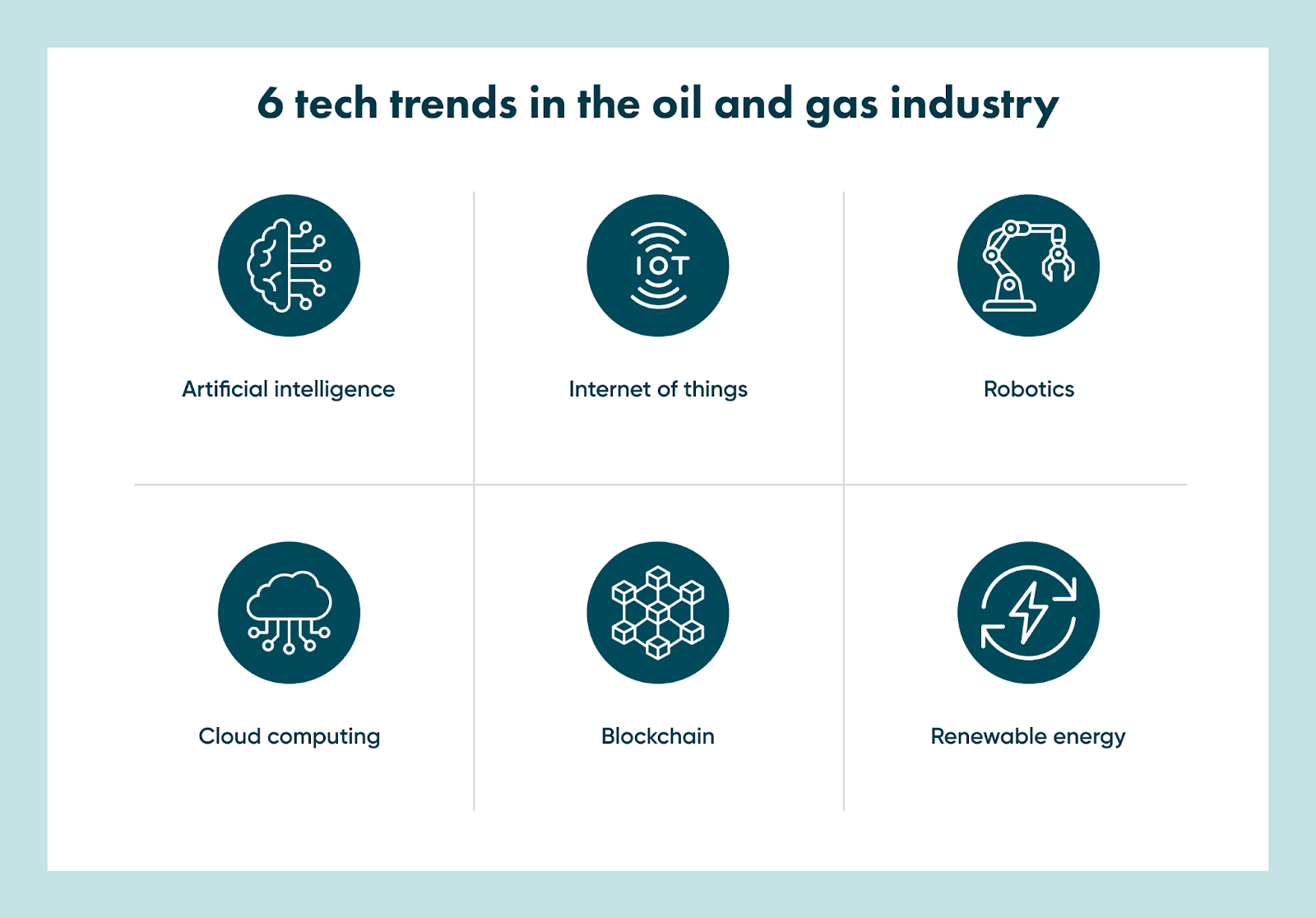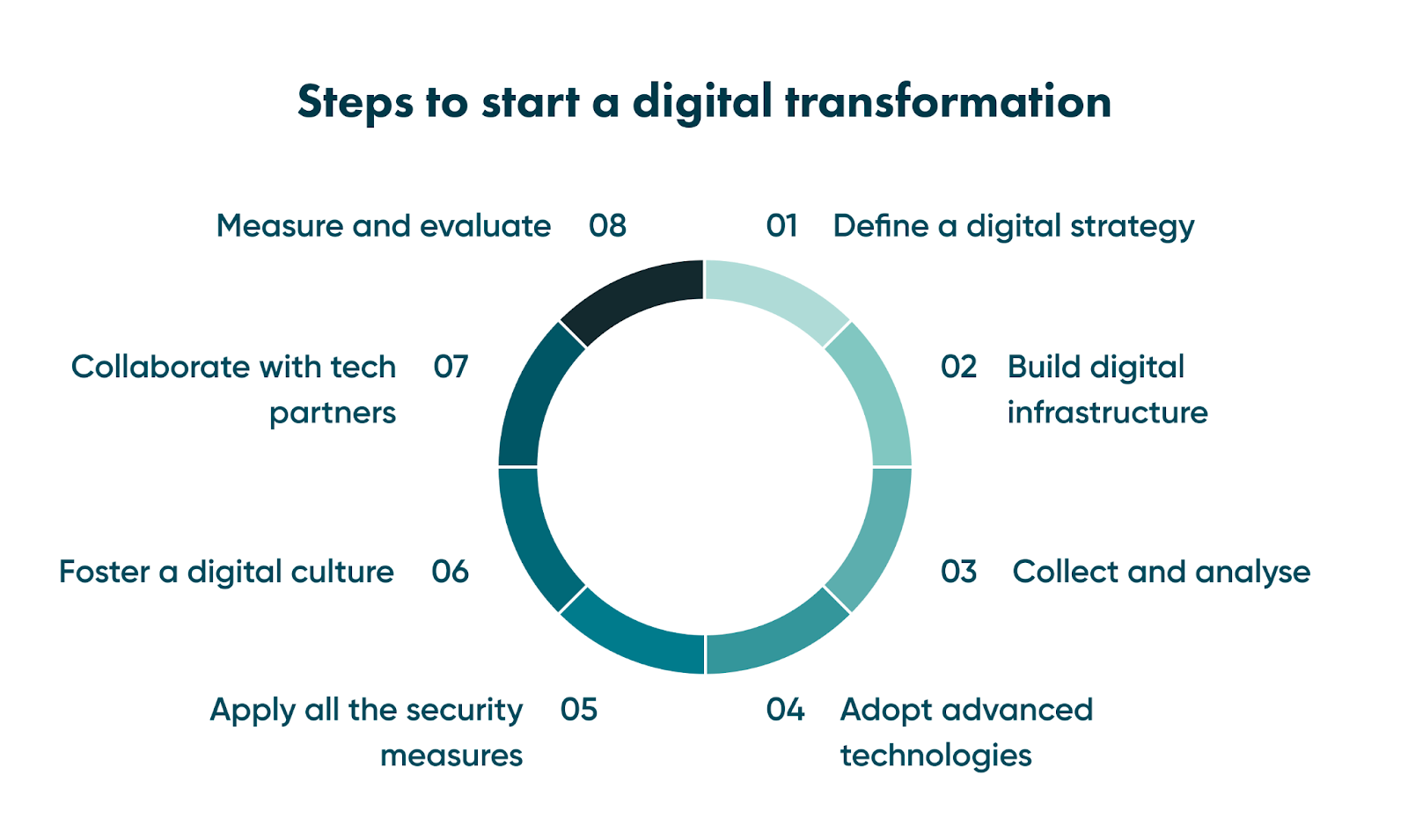Digital Transformation in the Oil and Gas Industry


Digital Transformation in the Oil and Gas Industry
Since the first successful well-drilling mission in 1859, the oil and gas industry has been known for its reliance on innovative practices and technologies. With the rise of new technologies, there is no doubt that we’re in the midst of a massive oil and gas digital transformation.
The digital transformation in the oil and gas industry involves adopting digital technologies and data analytics to optimise operations, increase efficiency, and reduce costs.
Furthermore, the integration of digital technologies is expected to revolutionise the oil and gas industry by improving production, enhancing safety, and reducing the industry's environmental impact.
In this article, we will explore the concept of digital transformation in the oil and gas industry, its benefits, and the latest trends and innovations driving this transformation.
Why is digital transformation in the oil and gas industry significant?
The fluctuation of demand and other changes have opened the door for new technology integration that aids in the exploration and development of oil fields.
Today, conservative companies already test and integrate oil and gas technologies on a constant basis. These companies also study other industries to find new opportunities to increase the efficiency of basic processes and decision-making processes.
To achieve their goals, corporations need to cover all the processes related to working with oil, like exploration, extraction, transportation, storage, refining, and marketing. The result depends on comprehensive improvements and the problem-solving skills of buyers and/or suppliers.
Oil and gas software is at the heart of all these processes.
In the energy sector, COVID-19 and other factors have produced a perfect storm that threatens to obliterate profits and cast the industry into chaos.
Oil prices have plummeted, and many companies are struggling in their current state. The only viable solution is accelerating digitalisation by investing in futuristic technology in the oil and gas industry, like the internet of things and artificial intelligence, that can help save costs by increasing efficiency while decreasing pollution.
Data comes first: How oil and gas companies should start processing data
Data is the first resource oil and gas companies work with, so it may just be the most important.
Oil and gas companies receive tons of data from sensors and mechanisms located in large areas. The main goal is to obtain operational data from a specific point, analyse them in real time, and use these results to improve performance.
Thus, to make all the data benefit your business, oil and gas companies must solve 3 main tasks: the automation of data collection, the integration of data from multiple sources, and the analysis of information to obtain operational information.

1. Automate data collection
With new oil and gas technology, companies can analyse real-time data and use it to their business advantage. For example, a typical oil and gas platform on the ocean generates about 1-2 terabytes of data every single day.
The major part of this data remains valuable only within a short period. It takes about 12 days on average for satellite communication (the most common channel) to transfer a day’s data volume to the central repository.
However, when companies use cloud computing solutions, all data can be processed instantly. Specialists can determine whether the data must be sent to the central repository or is to be analysed on the spot.
2. Data integration
Data integration is more challenging since data is collected from heterogeneous and distributed sources such as embedded sensors, video cameras, and other third-party sources.
Therefore, many companies resort to virtualisation to ensure that all data sources are perceived as one logical database, regardless of data format and location.
As the integration is performed “on the fly”, there is no need for centralised physical storage: integration occurs when the user requests data from several separate sources.
Integration on demand gives users instant access to data in the required time and format.
Commonly, oil and gas companies gather and integrate data manually. Due to data virtualisation, it becomes possible to take appropriate actions to increase efficiency and profitability.
In the oil and gas industry, technology can become a resource that works some real magic.
3. Data analysis
The analysis is required to obtain operational information that helps improve results.
This information can be used to re-organise production processes and transform business. To use all the information they have available effectively, oil and gas companies need to leverage big data algorithms capable of processing growing large sets.
But of course, companies also require skilled specialists who know how to work with new tools. Data analysis provides many benefits, including improving the ability to make better decisions.
Are you planning to digitalise your business? Go Wombat is here to help — contact us.
How the oil and gas industry benefits from new technologies
Digital transformation refers to integrating virtual technologies into all business areas, fundamentally changing how the company operates and delivers value to clients.
In the oil and gas industry, digital transformation can bring significant benefits. Let’s review them below.

Enhanced operational efficiency
Digital transformation enables the automation of many operational processes, reducing the need for manual intervention and increasing productivity. This can lead to more efficient use of resources, improved asset performance, and reduced downtime.
Higher safety level
Digital technologies can help monitor, detect, and mitigate safety risks by providing real-time data, predictive analytics, and automation. This can help to reduce accidents, injuries, and fatalities.
Increased profitability
Oil and gas companies can optimise production, reduce costs, and improve supply chain management. This often leads to increased profitability and competitiveness.
Improved decision-making
Digital technologies can provide real-time data, predictive analytics, and visualisation tools to help decision-makers make more informed and data-driven decisions.
As a result, it can lead to better resource allocation and improved business outcomes.
Better client experience
With oil and gas digitalisation, companies can better understand their client's needs, preferences, and behaviours.
It enables companies to deliver personalised products and services that meet their clients' needs more effectively.
High sustainability
This advantage allows companies to reduce their environmental impact by optimising their processes, reducing waste, and increasing energy efficiency.
Thus, through digital transformation, oil and gas corporations may support their sustainability goals and reduce their carbon footprint.
Innovation
Digital transformation can drive innovation by enabling the development of new products, services, and business models. As a result, new revenue streams and opportunities for growth may be opened up.
Top 6 technology trends in the oil and gas industry
As we’ve seen, oil and gas industry technology constantly evolves and adapts to new trends to improve operations, increase efficiency, and reduce costs. Moreover, technology will continue to shape the current state and overall advancement of the entire field.
Here are some of the top technology trends in the oil and gas industry.

Artificial intelligence and machine learning
The oil and gas industry uses AI and machine learning to optimise exploration, drilling, and production processes.
For example, AI algorithms can analyse seismic data to identify potential drilling sites, while machine learning can predict equipment failure and optimise maintenance schedules. This can help companies reduce downtime and optimise maintenance schedules, significantly saving costs.
Also, in reservoir modelling, artificial intelligence allows for building more accurate reservoir models to help companies maximise production and increase recovery rates.
AI algorithms can analyse data from sensors and other sources to identify and proactively mitigate potential safety risks.
Check out our detailed article to learn more about AI potential in the oil and gas (O&G) industry.
Internet of things
The internet of things (IoT) is a rapidly growing trend in the O&G industry. IoT sensors and devices monitor O&G production processes in real time. It can help companies detect equipment failures, prevent accidents, and optimise production processes.
IoT sensors can generate large amounts of data, which can be analysed to gain insights into production processes, equipment performance, and other aspects of the operation.
This, in turn, can contribute to optimising O&G companies’ operations and reducing costs.
Overall, the trend towards IoT in the oil and gas industry is expected to grow as companies seek to improve efficiency, safety, and profitability.
Robotics
Another oil and gas innovation is robotics. Robots and drones in the oil and gas industry can inspect and maintain equipment in hard-to-reach or dangerous locations. If implemented properly, this can improve safety, reduce costs, and increase efficiency.
Robots can be used for tasks such as lifting heavy objects, transporting equipment, and loading and unloading cargo, minimising the risk of injuries for operators.
Besides that, autonomous underwater vehicles (AUVs) and remotely operated vehicles (ROVs) are starting to play a vital role in subsea exploration and drilling.
Cloud computing
Cloud computing refers to delivering computing services, including storage, processing, and applications, over the internet.
With cloud solutions, you can store and analyse data, which is massive in volume. Companies can identify patterns and trends, optimise processes, and make data-driven decisions using new oil and gas digital technology.
Cloud computing allows companies to store and manage large amounts of data securely and centrally. Specialists can analyse the data using advanced analytics tools to gain insights into production processes, equipment performance, and other aspects of the operation.
Blockchain
Blockchain is a decentralised, distributed ledger technology that allows for secure and transparent data storage and transactions.
The implementation of blockchain technology can improve supply chain management and reduce fraud.
For example, blockchain can track crude oil's origin and movement from the wellhead to the refinery, ensuring transparency and accountability throughout the process.
However, the primary use case of blockchain is to create and execute smart contracts. In simple terms, these are self-executing contracts that automatically enforce the terms and conditions of an agreement.
Smart contracts provide various applications, including procurement, logistics, and supply chain management.
Renewable energy
The oil and gas industry is adopting renewable energy technologies such as wind and solar power to reduce greenhouse gas emissions and diversify revenue streams.
Many oil and gas companies invest in renewable energy projects and explore new business models that combine traditional fossil fuel production with renewable energy generation. This oil and gas innovation technology allows companies to make their contributions to an eco-friendly environment.
Go Wombat has been working with intelligent oil and gas technologies for many years, so we know how to implement them efficiently — contact us.
8 steps to digital transformation
Digital transformation is time-consuming and challenging, so O&G companies should know the steps to take if they want the process to go smoothly.

1. Define a digital strategy
Identify key business objectives, assess current technology capabilities, and create a roadmap for digital transformation.
This is essential to better understand and define what exactly you need.
2. Build digital infrastructure
You must upgrade existing infrastructure or invest in new technology platforms to support digital transformation initiatives.
Go Wombat will help you achieve this part and ensure it works well with all other steps.
3. Collect and analyse
Now, it’s time to focus and create a plan for data collection from various sources, including sensors, machines, and human operators.
Analyse this data using advanced analytics tools to gain insights into operational performance and identify areas for improvement.
4. Adopt advanced technologies
If you want to streamline your business processes, improve decision-making, and take your business to the next level, your oil and gas business will significantly benefit from IoT, AI, cloud computing and other technologies.
New technology in oil and gas may give a company a second wind.
5. Apply all the security measures
Next, you should implement robust security measures to protect sensitive data and ensure compliance with regulations.
Your business must have upgraded online protection since gaps in cybersecurity may cost you a lot. Security measures may include encryption, multifactor authentication, and regular security audits.
6. Foster a digital culture
Foster a digital culture within the organisation by promoting innovation, collaboration, and continuous learning. You should also provide training and development opportunities for employees to acquire digital skills and knowledge.
7. Collaborate with tech partners
Collaborate with technology partners, suppliers, and other stakeholders to leverage their expertise and capabilities in achieving digital transformation.
This may include collaborating on research and development initiatives, co-creating new technologies, and sharing data as well as insights.
8. Measure and evaluate
By tracking progress with key performance indicators (KPIs), you can measure success against your goals and identify areas of improvement.
Evaluate the results of digital transformation roadmap initiatives over time to gain insights into their success in improving business operations, client experience, and other key areas. Finally, use client feedback to refine strategies further and optimise the roadmap.
Conclusion
Today, digital transformation is essential not only for the oil and gas business, but for almost all other industries. If you own an O&G organisation, you need to adopt modern technologies which will improve your business and let you automate many routine processes.
Go Wombat provides software development services of all complexity levels, so we can create any type of software for your O&G company from scratch.
We always consider all requirements and expectations of our clients. In addition, our business analysts conduct a detailed analysis of your niche as well as requirements to identify potential benefits and risks.
Get on the forefront and gain an advantage through custom oil and gas software development — contact Go Wombat today to learn more!
Unlock Success with Premium Software Development
Contact us


Oil and gas industry software FAQ
What is digital transformation in the oil and gas industry?
Digital transformation in the oil and gas industry refers to integrating digital technologies into all sectors, from exploration and production to transportation and distribution. This process aims to improve efficiency, reduce costs, enhance safety, and increase sustainability.
What are the challenges of digital transformation in the oil and gas industry?
We can single out three main challenges:
- Legacy systems and infrastructure - the oil and gas industry has a history of using legacy systems and infrastructure that can be difficult and expensive to upgrade.
- Data integration - oil and gas companies must deal with massive amounts of data from various sources, including sensors, machines, and humans. Integrating this data into a centralised system can be complex and tedious.
- Regulation compliance - the oil and gas industry is subject to a complex web of regulations and standards, which can vary by country and region. Digital transformation initiatives must comply with these regulations, which can be a significant challenge.
What is a new technology in oil and gas?
There is no one new technology — many new technologies are constantly being developed and implemented in the oil and gas industry. Some current examples include: artificial intelligence with machine learning (AI subset), the internet of things, blockchain, cloud computing, robotics, and renewable energy.
How can we help you ?




